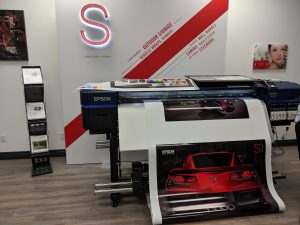
There are three primary types of wide-format printers, including flatbed, roll-to-roll, and hybrid systems (capable of printing rolled as well as flat substrates).
Trends driving application growth
Retailers, event exhibitors, and designers are always seeking the next big thing to make their sign and display graphics stand out. Here are a few reasons the above trending applications are experiencing growth:
- Fabric graphics offer the richer, more eye-catching colours that big brand owners want. They can be folded, reused, and are also less expensive to ship and install. As a result, soft signage applications are highly appealing.
- Architects, interior designers, and homeowners are looking to customize their interior environments. Digitally printed wallpaper, upholstery, and tiles are just a few of the higher-demand applications in the growing decor market.
- Wide-format is helping to transform the packaging industry by enabling smaller print runs of custom packaging and labels. Packaging is an attractive print market because it cannot be displaced by electronic alternatives.
Tips for targeting a vertical market
The most successful wide-format providers actively target the most profitable customers that need their services. By focusing marketing and sales efforts on a targeted vertical industry that requires wide-format applications, providers can make better use of their resources and gain an in-depth understanding of that industry.
Focusing on one (or several) industries offers many benefits to the marketing and operations sides of a business. Key benefits of targeting a specific vertical market include:
- Commanding attention in a selected industry. Tailoring products and services to meet a select industry’s specific needs makes it easier to get that market’s attention and win sales.
- Positioning an organization as an industry expert. Being viewed as an expert in the marketplace differentiates an organization and positions it as a go-to resource.
- Focusing marketing efforts to drive results. Understanding the nuances of a vertical market generates reality-based sales and marketing messages that demonstrate a clear understanding of prospective customers’ needs. For example, the things that matter to a financial services firm are very different from the things that matter to a retail operation.
- Maximizing internal resources. By understanding the specific needs of a target industry, an organization can best leverage its internal capabilities to deliver the right mix of offerings.
- Developing new applications. A specialized focus also provides the insight necessary to create new, high-demand applications.
- “Talking the talk.” To win business, it is important to speak the language of the customer’s industry and truly understand the terminology.

Printing devices (roll-fed, flatbed, or hybrid) typically dictate the type of substrates (rigid, flexible, or both) that can be used, but there are many media options for each type.
Identifying vertical market opportunities
Given all industries use wide-format applications, there are a number of vertical industries to consider. When identifying the industries that are the best fit for a shop, start by asking the following questions.
Who are the customers?
First, evaluate the company and customers. Identify the customers that are the most profitable and that you enjoy working with by answering the following questions:
- Where are you successful today?
- Who are your customers?
- What markets do they serve?
- What are the key characteristics of your existing base?
- Size?
- Profitability?
- Products and services purchases?
- Pain points?
- Can you sell more to those customers?





